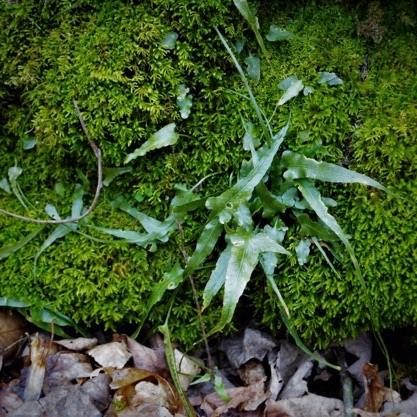By Nikki May
Although the forest seems bleak on a mid-November morning, members and friends of Saugeen Nature found many thriving species, large and small, to marvel over. There are several trails running through this Grey County Forest north of Williamsford; the forest itself is rich with a variety of native wildlife. At this time of year, the muted greys and browns of the tree trunks and fallen leaves are enlivened by the bright greens of the mosses and ferns that survive the early frosts. A hush stands over the interior woodland; even the squirrels are quiet, although we see signs of their presence in the piles of discarded cone scales on fallen logs.
The Fish Hatchery Forest is located on the Banks Moraine, and scattered rocks covered with mosses, lichens and liverworts stand out on the forest floor at this time of year. Most of the rocks are limestone, but there are a few granitic glacial erratics which offer a more acidic habitat for rock-loving species. The Rose Moss, so called because it grows into little rosettes of leaves on short stems, stood out a bright kelly green among the lighter feather and fern mosses growing alongside. Mosses grow on rotting logs as well, sharing both habitats with two other low- growing families, lichens and liverworts.
Mosses are very small plants which have leaflets containing photosynthetic cells, and stems like trees and wildflowers. Unlike trees or flowering plants however, mosses do not have vascular cells so that they can only absorb moisture directly from their surroundings. Nor do they reproduce by seeds, but rather produce spores, like ferns. Lichens are quite different. This family is actually a very close symbiotic association of an alga which can photosynthesize and a fungus which provides the structure for the system. The alga provides the nutrients that the organism needs to grow, and the fungus protects the alga from drying out and sun damage. On our travels through the woods, we saw several different lichen species. They are frequently greyish or ashy in colour and have cups or ‘horn’ protruding above the flatter scales of the rest of the plant. Other species have a branching growth. The range of colours can include oranges, yellows and browns. Liverworts are very simple photosynthesizing plants. They are divided into two groups, leafy liverworts and thalloid liverworts. Leafy liverworts are the most common. The leaves are only one photosynthetic cell thick and lie flat against a surface with hairy rhizae or rootlets anchoring them to the substrate underneath. Look for plants with no stems, very broad leaves laying close to the ground.


The largest plants that retain their summer green at this time of year, the ferns, are well represented in the Fish Hatchery Forest. Two species which are easy to identify caught our attention on this cold grey day; Holly Fern and the Walking Fern. A beautiful specimen of
the Holly Fern was seen growing right beside the trail. The blades stood up to form a perfect vase shape and the bright green contrasted beautifully with the goldy brown of the fallen leaves on the forest floor. The Walking Fern was found on a large rock not far from the trail. The blades of this small fern grow in a vase-like form from the rhizome. The end of each blade tapers to a long thread-like tip which seems to search along the nearby rock for a suitable crevice. The tip will then root in the fertile spot and start a new specimen that grows into a mature multi-bladed individual. We spotted several ‘babies’ growing at the ends of mature blades as the fern ‘walked’ across the rock surface.


Fern
At the end of a satisfying foray, participants walked out of the forest into a sunny afternoon. We look forward to the next time we can get together safely outside to share the wonders of nature.


